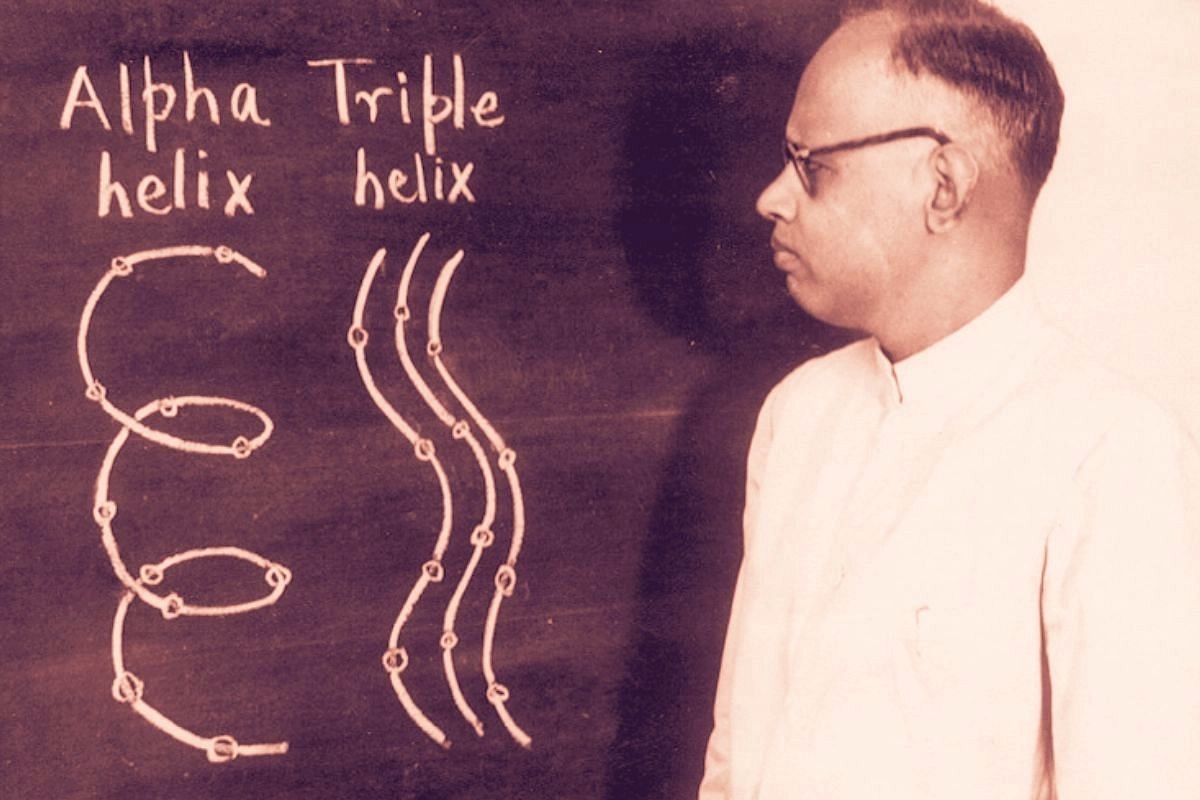Science
G N Ramachandran - The Great Indian Scientist's Centenary Birthday Today
- Behind the triple helix model and the Ramachandran plot, G N Ramachandran put Madras on the map of science.

GNR explaining Triple Helix to his students.
If you happen to go to the Central Leather Institute in Madras then you will find an auditorium with a unique name 'Triple Helix'.
The reason behind the name was a genius from Madras - a Nobel class scientist but seldom known outside the small circle of scientists.
Triple Helix is the structure of a protein called collagen. It is the important protein essential for the connective tissues, tendons, ligaments, cartilage and bone.
Gopalasamudram Narayanan Ramachandran, or simply GNR, with his first post-doctorate student Gopinath Kartha in a paper published in the magazine Nature in 1954, 'Structure of Collagen', proposed the triple helical structure.
In this paper the Indian scientists proposed collagen structure as having three parallel left-handed helical chains. Later based on data from more elaborate studies. In this model the three left-handed helical chains coiled around a central axis in a right-handed way.
GNR had proposed in his model two hydrogen bonds between these interchains. This model became famous as 'Madras Triple Helix.'
Let us pause here and remember that India had just then won her freedom. The science-research infrastructure were not by any stretch of imagination globally competitive.
Professor V Sasisekharan, one of the scientific collaborators of GNR, in a paper pointed out how GNR and his team sitting in a not-so well equipped rooms, that too from a nation considered the backwaters of science then, matched skills and even beat the best teams in the world who were engaged in the quest for discovering the structure of collagen:
Due credit has not been given to GNR for this important discovery.
But why the auditorium in Central Leather Institute should be named 'Triple Helix'? Because for his work on collagen, GNR then working in Madras University, borrowed quite a large amount of kangaroo tail tendon from the Institute for his X-ray diffraction studies.
One should mention here particularly the complete freedom and patronage that was given to GNR by Padma Vibushan Arcot Lakshmanaswami Mudaliar (1887–1974).
After Mudaliyar, the university was headed by people who seldom understood the greatness of the work done by GNR.
His strong and rigourous commitment to the problems in biophysics were not reciprocated even by the then coming students and colleagues. The man who had become the head of the department when he was 30, now suffered an isolation. And yet he worked.
In a way GNR was an outsider to the field in which he made the impossible possible. He was working on optics and diffraction theory under CV Raman.
In the first year of his pre-doctoral studied he came across two books in his shelf. One was 'Nature of the Chemical Bond' by Linus Pauling and 'Natural and Synthetic High Polymers' by Kurt Meyer.
He was so enamoured by the subject. He wrote: 'I took crystal chemistry as anextracurricular subject of study and as part of this, crystal structures came in serious consideration.'
He also developed the famous Ramachandran Plot that has been a beautiful mathematical tool that help researchers unravel protein structures.
Apart from his personal extraordinary accomplishments, he also was into organising international conferences, what became famous in 1950s as 'Madras Conferences', on the problems in molecular structures-particularly the bio-polymers.
Most eminent scientists of the world used to attend the event and give lectures.
Today is the 100th birth anniversary of this great man. The new India that puts special emphasis on STEM education as well as self-assertion is celebrating its seventy-fifth year of Independence.
GNR personifies all these values: setting standards for doing science, institution building, remaining in India to further science and a rootedness in Indian heritage.
India should honour him at least now in the way he deserved to be honoured.
Introducing ElectionsHQ + 50 Ground Reports Project
The 2024 elections might seem easy to guess, but there are some important questions that shouldn't be missed.
Do freebies still sway voters? Do people prioritise infrastructure when voting? How will Punjab vote?
The answers to these questions provide great insights into where we, as a country, are headed in the years to come.
Swarajya is starting a project with an aim to do 50 solid ground stories and a smart commentary service on WhatsApp, a one-of-a-kind. We'd love your support during this election season.
Click below to contribute.
Latest